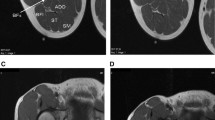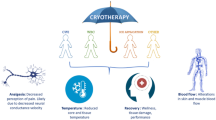Abstract
Purpose
A brief compressive stimulus is known to induce a rapid hyperemia in skeletal muscles, considered to contribute to the initial phase of functional hyperemia. Whether the same mechano-sensitivity characterizes the cutaneous circulation is debated. This study aims to investigate whether a rapid hyperemic response to compressive stimuli is also expressed by skin blood flow in humans.
Methods
In 12 subjects, brief compressive stimuli were delivered to the forearm at varying pressures/durations (50/2, 100/2, 200/2, 200/1, 200/5 mmHg/s); the sequence was randomized and repeated with the arm above and below heart level. Laser Doppler flowmetry technique was used to monitor skin blood flow. The response was described in terms of peak skin blood flow normalized to baseline (nSBFpeak), time-to-peak from the release of compression, and excess blood volume (EBV, expressed in terms of seconds of basal flow, s-bf) received during the response.
Results
The results consistently evidenced the occurrence of a compression-induced hyperemic response, with nSBFpeak = 2.9 ± 1.1, EBV = 17.0 ± 6.6 s-bf, time-to-peak = 7.0 ± 0.7 s (200 mmHg, 2 s, below heart level). Both nSBFpeak and EBV were significantly reduced (by about 50%) above compared to below heart level (p < 0.01). In addition, EBV slightly increased with increasing pressure (p < 0.05) and duration (p < 0.01) of the stimulus.
Conclusions
For the first time, the rapid dilatator response to compressive stimuli was demonstrated in human cutaneous circulation. The functional meaning of this response remains to be elucidated.




Similar content being viewed by others
Abbreviations
- ANOVA:
-
Analysis of variance
- Bsl:
-
Baseline
- EBV:
-
Excess of blood volume
- IPC:
-
Intermittent pneumatic compression
- LDF:
-
Laser Doppler flowmetry
- PCRH:
-
Post-compressive reactive hyperemia
- PORH:
-
Post-occlusive reactive hyperemia
- s-bf:
-
Seconds of basal blood flow
- SBF:
-
Skin blood flow
References
Brock RW, Tschakovsky ME, Shoemaker JK, Halliwill JR, Joyner MJ, Hughson RL (1998) Effects of acetylcholine and nitric oxide on forearm blood flow at rest and after a single muscle contraction. J Appl Physiol 85(6):2249–2254
Broxterman RM, Trinity JD, Gifford JR, Kwon OS, Kithas AC, Hydren JR, Nelson AD, Morgan DE, Jessop JE, Bledsoe AD, Richardson RS (2017) Single passive leg movement assessment of vascular function: contribution of nitric oxide. J Appl Physiol (1985) 123(6):1468–1476. https://doi.org/10.1152/japplphysiol.00533.2017
Clifford PS (2007) Skeletal muscle vasodilatation at the onset of exercise. J Physiol 583(Pt 3):825–833. https://doi.org/10.1113/jphysiol.2007.135673
Clifford PS, Tschakovsky ME (2008) Rapid vascular responses to muscle contraction. Exerc Sport Sci Rev 36(1):25–29. https://doi.org/10.1097/jes.0b013e31815ddba4
Clifford PS, Kluess HA, Hamann JJ, Buckwalter JB, Jasperse JL (2006) Mechanical compression elicits vasodilatation in rat skeletal muscle feed arteries. J Physiol 572(Pt 2):561–567. https://doi.org/10.1113/jphysiol.2005.099507
Comerota AJ (2011) Intermittent pneumatic compression: physiologic and clinical basis to improve management of venous leg ulcers. J Vasc Surg 53(4):1121–1129. https://doi.org/10.1016/j.jvs.2010.08.059
Corcondilas A, Koroxenidis GT, Shepherd JT (1964) Effect of a brief contraction of forearm muscles on forearm blood flow. J Appl Physiol 19:142–146
Crecelius AR, Kirby BS, Luckasen GJ, Larson DG, Dinenno FA (2012) ATP-mediated vasodilatation occurs via activation of inwardly rectifying potassium channels in humans. J Physiol 590(Pt 21):5349–5359. https://doi.org/10.1113/jphysiol.2012.234245
Crecelius AR, Kirby BS, Luckasen GJ, Larson DG, Dinenno FA (2013a) Mechanisms of rapid vasodilation following a brief contraction in human skeletal muscle. Am J Physiol Heart Circ Physiol 305(1):H29–40. https://doi.org/10.1152/ajpheart.00298.2013
Crecelius AR, Kirby BS, Richards JC, Dinenno FA (2013b) Mechanical effects of muscle contraction increase intravascular ATP draining quiescent and active skeletal muscle in humans. J Appl Physiol 114(8):1085–1093. https://doi.org/10.1152/japplphysiol.01465.2012
Credeur DP, Holwerda SW, Restaino RM, King PM, Crutcher KL, Laughlin MH, Padilla J, Fadel PJ (2015) Characterizing rapid-onset vasodilation to single muscle contractions in the human leg. J Appl Physiol (1985) 118(4):455–464. https://doi.org/10.1152/japplphysiol.00785.2014
Eze AR, Comerota AJ, Cisek PL, Holland BS, Kerr RP, Veeramasuneni R, Comerota A Jr (1996) Intermittent calf and foot compression increases lower extremity blood flow. Am J Surg 172(2):130–135
Farnebo S, Thorfinn J, Henricson J, Tesselaar E (2010) Hyperaemic changes in forearm skin perfusion and RBC concentration after increasing occlusion times. Microvasc Res 80(3):412–416
Ferraresi C, De Benedictis C, Maffiodo D, Franco W, Messere A, Pertusio R, Roatta S (2019) Design and simulation of a novel pneumotronic system aimed to the investigation of vascular phenomena induced by limb compression. J Bionic Eng 16(3):550–562
Folkow B (1949) Intravascular pressure as a factor regulating the tone of the small vessels. Acta Physiol Scand 17(4):289–310
Fry BC, Roy TK, Secomb TW (2013) Capillary recruitment in a theoretical model for blood flow regulation in heterogeneous microvessel networks. Physiol Rep 1(3):e00050
Henni S, Hersant J, Loufrani L, Duval G, Humeau-Heurtier A, Riou J, Abraham P, Group S, Research SGJM ( 2019) Painless local pressure application to test microvascular reactivity to ischemia. Random Control Trial 122:13–21
Hughes WE, Ueda K, Treichler DP, Casey DP (2015) Rapid onset vasodilation with single muscle contractions in the leg: influence of age. Physiol Rep 3(8):e12516
Husmann M, Willenberg T, Keo HH, Spring S, Kalodiki E, Delis KT (2008) Integrity of venoarteriolar reflex determines level of microvascular skin flow enhancement with intermittent pneumatic compression. J Vasc 48(6):1509–1513
Jan Y-K, Brienza D, Boninger M, Brenes G (2011) Comparison of skin perfusion response with alternating and constant pressures in people with spinal cord injury. Spinal Cord 49(1):136
Jasperse JL, Shoemaker JK, Gray EJ, Clifford PS (2015) Positional differences in reactive hyperemia provide insight into initial phase of exercise hyperemia. J Appl Physiol 119(5):569–575. https://doi.org/10.1152/japplphysiol.01253.2013
Jepsen H, Gaehtgens P (1993) Postural vascular response in human skin: passive and active reactions to alteration of transmural pressure. Am J Physiol 265(3 Pt 2):H949–958
Kindig CA, Richardson TE, Poole DC (2002) Skeletal muscle capillary hemodynamics from rest to contractions: implications for oxygen transfer. J Appl Physiol 92(6):2513–2520. https://doi.org/10.1152/japplphysiol.01222.2001
Kirby BS, Carlson RE, Markwald RR, Voyles WF, Dinenno FA (2007) Mechanical influences on skeletal muscle vascular tone in humans: insight into contraction-induced rapid vasodilatation. J Physiol 583(Pt 3):861–874. https://doi.org/10.1113/jphysiol.2007.131250
Labropoulos N, Leon LR Jr, Bhatti A, Melton S, Kang SS, Mansour AM, Borge M (2005) Hemodynamic effects of intermittent pneumatic compression in patients with critical limb ischemia. J Vasc Surg 42(4):710–716. https://doi.org/10.1016/j.jvs.2005.05.051
Leyk D, Eßfeld D, Hoffmann U, Wunderlich H-G, Baum K, Stegemann J (1994) Postural effect on cardiac output, oxygen uptake and lactate during cycle exercise of varying intensity. Eur J Appl Physiol Occup Physiol 68(1):30–35
Lynn MJ, Mew OK, Drouin PJ, Liberman NL, Tschakovsky ME (2019) Greater post-contraction hyperaemia below vs. above heart level: the role of active vasodilatation vs. passive mechanical distension of arterioles. J Physiol 598:85–99
Mayrovitz HN, Sims N, Dribin L (2003) Heel skin hyperaemia: direct compression versus vascular occlusion. Clin Trial 23(6):354–359
Mellander S (1989) Functional aspects of myogenic vascular control. J Hypertens Suppl 7(4):S21–30
Messere A, Roatta S (2013) Influence of cutaneous and muscular circulation on spatially resolved versus standard Beer-Lambert near-infrared spectroscopy. Physiol Rep 1(7):e00179. https://doi.org/10.1002/phy2.179
Messere A, Ceravolo G, Franco W, Maffiodo D, Ferraresi C, Roatta S (2017) Increased tissue oxygenation explains the attenuation of hyperemia upon repetitive pneumatic compression of the lower leg. J Appl Physiol 123(6):1451–1460. https://doi.org/10.1152/japplphysiol.00511.2017
Messere A, Turturici M, Millo G, Roatta S (2017) Repetitive muscle compression reduces vascular mechano-sensitivity and the hyperemic response to muscle contraction. J Physiol Pharmacol 68(3):427–437
Messere A, Pertusio R, Macrì C, Maffiodo D, Franco W, De Benedictis C, Ferraresi C, Roatta S (2018a) Delivery of customizable compressive patterns to human limbs to investigate vascular reactivity. Biomed Phys Eng Express 4(6):067003
Messere A, Tschakovsky ME, Seddone S, Lulli G, Franco W, Maffiodo D, Ferraresi C, Roatta S (2018b) Hyper-oxygenation attenuates the rapid vasodilatory response to muscle contraction and compression. Front Physiol 9:1078
Mohrman DE, Sparks HV (1974) Myogenic hyperemia following brief tetanus of canine skeletal muscle. Am J Physiol 227(3):531–535
Morgan R, Carolan G, Psaila J, Gardner A, Fox R, Woodcock J (1991) Arterial flow enhancement by impulse compression. Vasc Endovasc Surg 25(1):8–16
Nadland IH, Walloe L, Toska K (2009) Effect of the leg muscle pump on the rise in muscle perfusion during muscle work in humans. Eur J Appl Physiol 105(6):829–841. https://doi.org/10.1007/s00421-008-0965-6
Oresanya L, Mazzei M, Bashir R, Farooqui A, Athappan G, Roth S, Choi ET, van Bemmelen P (2018) Systematic review and meta-analysis of high-pressure intermittent limb compression for the treatment of intermittent claudication. J Vasc Surg 67(2):620–628
Roustit M, Cracowski J-L (2013) Assessment of endothelial and neurovascular function in human skin microcirculation. Trends Pharmacol Sci 34(7):373–384
Schubert R, Mulvany MJ (1999) The myogenic response: established facts and attractive hypotheses. Clin Sci (Lond) 96(4):313–326
Sheldon RD, Roseguini BT, Thyfault JP, Crist BD, Laughlin MH, Newcomer SC (2012) Acute impact of intermittent pneumatic leg compression frequency on limb hemodynamics, vascular function, and skeletal muscle gene expression in humans. J Appl Physiol (1985) 112(12):2099–2109. https://doi.org/10.1152/japplphysiol.00042.2012
Sheldon RD, Roseguini BT, Laughlin MH, Newcomer SC (2013) New insights into the physiologic basis for intermittent pneumatic limb compression as a therapeutic strategy for peripheral artery disease. J Vasc Surg 58(6):1688–1696. https://doi.org/10.1016/j.jvs.2013.08.094
Shoemaker JK, Tschakovsky ME, Hughson RL (1998) Vasodilation contributes to the rapid hyperemia with rhythmic contractions in humans. Can J Physiol Pharmacol 76(4):418–427
Slaaf D, Egbrink M (2002) Capillaries and flow redistribution play an important role in muscle blood flow reserve capacity. J Mal Vasc 27(2):63–68
Speden RN (1984) Active reactions of the rabbit ear artery to distension. J Physiol 351:631–643
Tschakovsky ME, Sheriff DD (2004) Immediate exercise hyperemia: contributions of the muscle pump vs rapid vasodilation. J Appl Physiol 97(2):739–747. https://doi.org/10.1152/japplphysiol.00185.2004
Tschakovsky ME, Shoemaker JK, Hughson RL (1996) Vasodilation and muscle pump contribution to immediate exercise hyperemia. Am J Physiol 271(4 Pt 2):H1697–1701
Turturici M, Roatta S (2013a) Compression-induced hyperaemia in the rabbit masseter muscle: a model to investigate vascular mechano-sensitivity of skeletal muscle. Physiol Meas 34:307–314
Turturici M, Roatta S (2013b) Inactivation of mechano-sensitive dilatation upon repetitive mechanical stimulation of the musculo-vascular network in the rabbit. J Physiol Pharmacol 64(3):299–308
Turturici M, Roatta S (2014) Effects of gadolinium chloride on basal flow and compression-induced rapid hyperemia in the rabbit masseter muscle. J Physiol Pharmacol 65(3):409–415
Turturici M, Mohammed M, Roatta S (2012) Evidence that the contraction-induced rapid hyperemia in rabbit masseter muscle is based on a mechanosensitive mechanism, not shared by cutaneous vascular beds. J Appl Physiol 113(4):524–531. https://doi.org/10.1152/japplphysiol.00237.2012
van Bemmelen PS, Mattos MA, Faught WE, Mansour MA, Barkmeier LD, Hodgson KJ, Ramsey DE, Sumner D (1994) Augmentation of blood flow in limbs with occlusive arterial disease by intermittent calf compression. J Vasc Surg 19(6):1052–1058
van Bemmelen PS, Weiss-Olmanni J, Ricotta JJ (2000) Rapid intermittent compression increases skin circulation in chronically ischemic legs with infra-popliteal arterial obstruction. VASA 29(1):47–52
Funding
This research was supported by local grants from the University of Torino (ROAS_RILO_17_01).
Author information
Authors and Affiliations
Contributions
SS, AM and SR conceived and designed the research. AM and SS conducted experiments and analysis of the data. All authors contributed to writing the manuscript. All authors read and approved the manuscript.
Corresponding author
Ethics declarations
Conflict of interest
No conflicts of interest, financial or otherwise, are declared by the authors.
Additional information
Communicated by I. Mark Olfert.
Publisher's Note
Springer Nature remains neutral with regard to jurisdictional claims in published maps and institutional affiliations.
Rights and permissions
About this article
Cite this article
Seddone, S., Messere, A. & Roatta, S. Vascular reactivity of cutaneous circulation to brief compressive stimuli, in the human forearm. Eur J Appl Physiol 120, 1041–1050 (2020). https://doi.org/10.1007/s00421-020-04343-3
Received:
Accepted:
Published:
Issue Date:
DOI: https://doi.org/10.1007/s00421-020-04343-3




